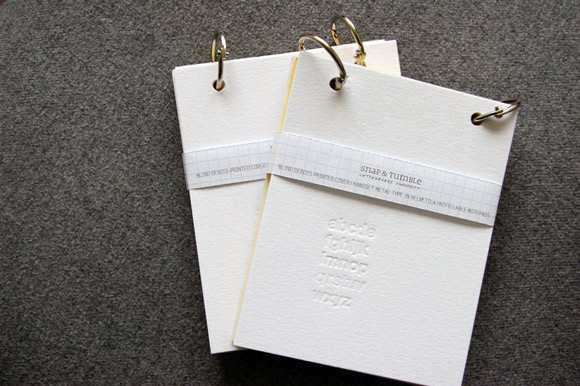Snap & Tumble is a one woman operation studio based in a home in Toronto, Canada. With just two table top presses and a showcard press, Tanya Roberts reminds us that if you put your mind to it, anything is possible. Since the spring of 2007, she has shared every trial and error of learning and mastering her tabletop presses on her blog.

What made you want to become an artist?
I never set out to become an artist. My love of craft printing and the desire to do letterpress – to search through antique markets for type or old printer’s blocks, to mix the ink, to operate the press itself, and to see the results of my labor – is what has led me to where I am today.

How did you first get into letterpress?
My desire emerged from the shadows – literally! I was in a stationery store and noticed the shadows formed by the deep impression on a card that had been made by a letterpress. I picked it up, ran my fingers over the type, and fell in love. From there, my curiosity took over. Probably the most important early move I made was taking a letterpress workshop at Open Studio which introduced me to a flatbed press. It was after doing the workshop that I decided to go out on a limb and get my own tabletop. From then on I’ve been self-taught but have been guided by the online letterpress community. One of the reasons I now offer workshops is so that other people have an easier time learning about letterpress than I initially did.

What was your very first press?
My first press is the Adana Eight-Five. It was perfect for me when I started out because it was small and it fit in my basement apartment kitchen. I’ve moved up to a 6.5 x 10 Canadian Craftsmen Machinery Co. press which is what I primarily use now. I’ve also added a small Showcard Press to the family.

What medium do you usually print (lead/wood type, photopolymer, lino, etc.)?
It depends on what I’m printing. I usually use Boxcar photopolymer plates and lead/wood type. I like making use of my type because I’ve acquired a great collection of the classics. I started off experimenting with magnesium dies mounted on wood, but ever since I tried out the polymer plates and registration, the Boxcar system seems to be the best for me.


What’s your process from sketch to press?
I tend to skip the hand-sketching part and go straight to Illustrator. There, I play with shapes and type, getting an idea of layout and composition. I don’t usually concern myself with color at this point. It’s not until I get the plates on the press that I’ll consider color and mix inks until I’m happy with what I see. Many times I simply experiment with moveable type – deciding all elements of design on the fly. Having a background in advertising design and copywriting, I think my brain is wired to latch onto anything type-related. Most of my product is type-heavy, making use of my beloved gothic wood and Poster Bodoni lead type. If I find something that I want to include in a design, I will scan it in to the computer. For example, there was an occasion when I found a vintage embroidery pattern book that included an exquisite alphabet. I scanned it into Photoshop, converted it to black and white, heightened the contrast and exported it to Illustrator. From there I traced the letters and it was ready for Boxcar.
What other print shops do you admire?
I’m consistently moved by the work of Maria Vettese from Port2Port Press. The simplicity of her prints is extraordinary.

Who or what inspires you the most?
In no particular order: I’m inspired by skillful typography, interesting use of colour, antique wood cuts, Hatch Show Print posters, Heather Smith Jones’s use of organic shapes, snail mail from friends, excellent design, and generally by passionate people who make stuff.

Any neat tricks you can share?
Here’s a tip for cleaning rollers: get a regular Rubbermaid plastic bin that’s just under the length of your rollers (pins included), drill a hole at each end of the bin. Slide the pins of the rollers into each hole. This way you’ve got both hands free to scrub instead of using one to hold the roller while the other rubs it clean.

What are you looking forward to?
There’s starting to be a real visible presence of letterpress printers in Toronto and I’m excited to see it grow. In terms of shows, I always look forward to the annual City of Craft fair and hopefully I’ll be able to attend the next Wayzgoose Festival in Grimsby, Ontario.  As for books, I’ve got for Reinventing Letterpress: Prints by Contemporary Artists on my wishlist.

Thanks Tanya! And if you’re in her neighborhood, be sure to check out Letterpress Curiosity Workshops especially if you want experience on a tabletop press.